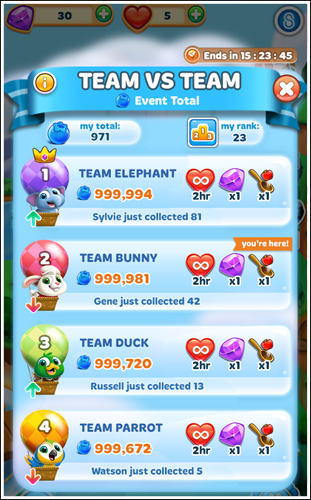
Featured Blog | This community-written post highlights the best of what the game industry has to offer. Read more like it on the Game Developer Blogs or learn how to Submit Your Own Blog Post
The Golden Goal Part 1: The Role of Events in Casual Puzzle Games
Reoccurring events have become a stable of casual puzzle games on mobile. From a design perspective, what are these events trying to achieve?

It’s intuitive that people play games to complete goals. At any given moment, players are trying to satisfy a goal on some level, even if it’s a goal they’ve set for themselves. An idea that may be less intuitive is that goals can exist on different timelines, and that your game will generally need to provide objectives along each of these vectors if you want it to have solid retention and the long-term stickiness indicative of meaningful gameplay.

Pictured above: the left image from Candy Crush Soda Saga shows how a level's objective can be easily summarized, and on the right we see how Wizard of Oz Match tries to add goals for a play session through quests. While casual puzzle games have traditionally had concise, appealing short term goals, long-term goals have been second priority or nonexistent. Until recently, these further out objectives have taken a back-seat despite their potential for making a more engaging experience for players and increasing the regularity of their sessions.
We can look at the most well known casual puzzle game as an example, the match3 mega-hit Candy Crush Saga. Candy Crush, and match3 games in general, have clear short-term goals tied into their easy to understand mechanics. For every match3 game, on a base level the player is looking to put 3 of the same things together. Matching 3 tiles can easily be communicated to the player, but a surprising amount of depth can come out of the system’s randomness and content layered on top of the matching. This accessibility and depth is a big contributor to the genre’s mass appeal.
In the case of Candy Crush Saga, every level revolves around immediate short term goals:
Find matches
Identify the optimal match for your current goal
Create the match and repeat
With the player base for Saga style Match3 games likely being completionists on some level, we can assume the long term goals align pretty closely with the game’s structure:
Beat every level in a group (e.g. "world", "island", etc)
Beat every level in the game
With mobile match3 games essentially being required to follow the F2P model, the traditional “beat the game” goal is out, but “beat every available” level is a suitable enough stand-in. The segmentation of levels into different areas of the map adds a sense of progression from clearing all the levels in a group. To help refresh the interest curve for the player, generally new mechanics are introduced on a regular interval, but it’s not uncommon for funding for these to dissipate over a game’s lifecycle. So, if beating every available level isn’t enough to keep a player logging back in (e.g. you want to broaden your player base), OR you want to extend the amount of time your players spend in game (i.e. session length), OR you want to add another engaging mechanic that incentivizes existing revenue streams, what’s a game designer to do? Recurring in-game events to the rescue!
The image above, taken from an article by game designer Stone Librande in Well Played 2.0: Video Games, Value, and Meaning, visualizes the reward scheduling for a single game session of Resident Evil 4's Mercenaries. Just as there can be second-to-second, minute-to-minute, day-to-day, etc. rewards in games (described in an excellent article by Librande here) these rewards can correspond to objectives given to players on the same schedule. As mentioned before, casual puzzle games typically have second-to-second and minute-to-minute objectives well defined, but lack the more long-term goals for players to work towards. When implemented correctly, in-game events are a possible solution, superimposing additional long term goals and rewards over the game’s core loop. Present in Candy Crush, Cookie Jam, and Candy Blast Mania to name a few, these events range from “reach level X within the time limit” to team based piece collection with leaderboards. The majority of these events are targeted at the existing player base, meant to increase monetization and session length. Through the introduction of secondary objectives with explicit rewards, a lot of these events meaningfully enrich the player's’ experience.
For example, the “Global Events” present in Storm8’s Hungry Babies (a game I worked on) introduces any number of secondary goals revolving around the game’s core mechanic: making matches. A piece is designated as the event’s focus, and collecting that piece adds to your event total. Multipliers are added for making larger matches and clearing levels, which adds a layer of rewards for player competency. Additionally, totals are tracked via an event leaderboard and players can be grouped into teams depending on event type, with larger rewards for teams that perform better. Smash tiles while smashing your opponents!! It's questionable whether competition alone plays a large part in match3 player motivations, but striving for more boosts is sure to get a puzzler’s blood pumping.

The bottom line is that events modify or strengthen key areas of casual games to improve the player experience:
Improved scheduling: Human psychology has a strong relationship with schedules. Who doesn’t like to look forward to something? Having different events on different schedules gives players something to look forward to. If there is downtime between events, then anticipation can build as well.
Dynamism / Gameplay Depth: Regardless of how well designed your levels are, players may become desensitized to similar gameplay after funding for new mechanics is diverted. Events create an additional layer of progression through event resources and their cyclical structure creates discrete moments of closure F2P games
Add value to existing mechanics: If your event gives x2 points for tiles cleared using special tiles, suddenly purchasing a boost to beat a level becomes a better deal for the player. The player gets to beat the level that they have been stuck on and get extra points towards earning event rewards.
Match3 games have evolved to the point that a lot of newer titles include the meta structures present in events in their core loop. In my next post I plan to talk about the integration of these concepts in games like Gardenscapes and Toon Blast, and how this signifies that player’s basic literacy in matching games has increased allowing for a third generation of tile matching games to emerge.
Read more about:
Featured BlogsAbout the Author(s)
You May Also Like







.jpeg?width=700&auto=webp&quality=80&disable=upscale)








